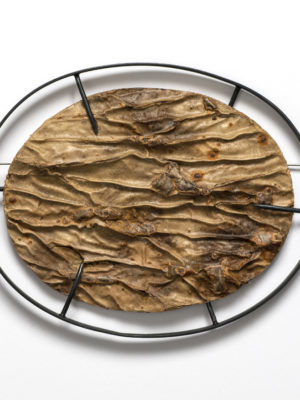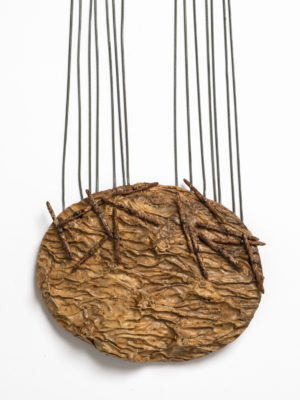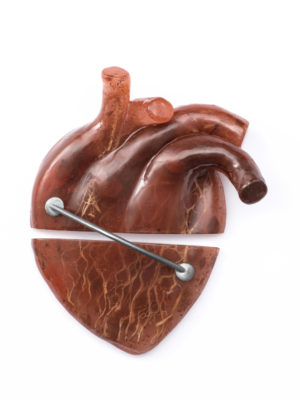Opuntia Ficus Indica is a fast growing and extremely drought tolerant plant originally from Mexico, same as Dania Chelminsky, a jewellery artist currently based in Israel. With her Opuntia series shown during Athens Jewelry Week 2019 she refers to this plant as an analogy to immigration, as a territorial symbol. Aside, she is intrigued by contrasting materials and their touching point. By using traditional metalsmithing techniques, Dania tries to emphasize these moments of tension to depict a story.

CURRENT OBSESSION
Firstly, what does ´creating´ mean to you?
DANIA CHELMINSKY
Creating is playing with materials and ideas, experimenting, challenging processes, innovating and sometimes surprising myself with results. It is illustrating an idea or feeling with material and form. It is a state of mind that I love, where I forget time and I often find myself very close to my core.
You work with a wide range of materials. In your own words, you’re combining the most contrasting ones, trying to create tension. Why is this material clash important to you?
Working with different materials is an essential part in my work, I try to convey my ideas not only by form but also by the materials that I choose to make the piece of. I feel that working with contrasting materials and creating kind of a tension between them, enables the piece to raise questions and ideas that I wish to emphasise.


In Opuntia series you are relating to a plant Opuntia Ficus Indica that symbolizes an intersection of cultures. Why did you choose immigration and intersectionality as a main and searing topic of your last collection?
I feel privileged to be making jewellery art and being able to convey ideas through it. I want to relate to this art medium not only as a way to make ‘accessories of adornment’ but mainly as a way to relate to the world that surrounds us. I want to relate to political global issues that have great impact on us, people. In this body of work I used the prickly pear plant, Opuntia ficus indica, as an analogy to immigration and intersectionality. This plant is of Mexican origin, an immigrant to Israel – like me. It has similar symbolism in very different cultures, the Mexican, Israeli and Palestinian. It symbolizes immigration, settlement, rootedness and locality. Immigration expresses not only a geographical movement from place to place but also an intercultural intersection and meeting. Immigrants adopt local characteristics while maintaining attributes of their original country, always carrying a conflict of identity. Immigrant groups that immigrate as groups to countries, change their original and new countries. Veterans and immigrants affect each other continuously and are both in a constant process of change. Today, immigration is an international phenomenon highly affecting political, cultural and economical aspects all over the world. In a transnational world characterized by fluid physical borders which enable human movement and cultural encounters that create new complex boundaries between people. I was born in Mexico and immigrated to Israel when I was a child with my family. Immigration characterizes my family in the last three generations. This work fuses a general narrative with my personal story. The personal becomes political.

Could you describe one of the exhibited pieces in more detail? Is there any particular story connected to it?
The Opuntia brooch series is based on a reflection of botanical aspects of the Prickly pear that relate to immigration. I chose to focus on three botanical aspects that characterize the plant’s ability to immigrate and adapt to new places: the plant’s spines, roots and joints. The spines get caught on animal fur and on human clothes, enabling the plant to immigrate from place to place. The roots can emerge from every part of the plant that falls to the ground, thus enabling the plant to grow on soil which doesn’t allow its seeds to sprout. The plant’s young joints are both fragile and flexible so stems and fruit can disconnect easily from the plant and fall to the ground. These aspects are reflected in the jewelry pieces as the mechanism by which the pieces are connected to clothes or being worn.
It is always complicated to choose one piece of a series… but I would like to point out Opuntia 6 . In this piece I used the spines not only as the mechanism by which the brooch attaches to clothes but also as fragile, unsoldered, thus detachable joints between the brooch components. In this brooch the spines are not only “adornments” but also functional. The spines are a flexible connecting system that affect the form, weight and flexibility of this piece and the way it is being worn.

With Heart Failure you exhibited also in Munich or Lille, now in Athens. Do you perceive any differences among exhibiting in various countries and different jewellery weeks?
It is interesting to try and answer this question. I think that both Munich and Athens jewellery weeks, although, their scale differ, are still drawing mainly the small contemporary jewellery community. I dare to think that these days, there is a grade of familiarity and similarity in contemporary jewellery made and shown in different countries, maybe because of greater connectivity due to easier travelling, student interchanges and technology. The contemporary jewellery is developing a kind of structural language which is interesting to follow its development.


What are the perks of being a part of AJW19?
AJW, organized by Erato Kouloubi and Niki Stylianou, both contemporary jewellery artists themselves, is in fact creating an interesting alternative and opportunity to show contemporary jewellery. This event is still evolving and relatively small. It shows a central exhibition and fewer independent exhibitions than in Munich, its scale is smaller and much personal, but it aims at a more innovative perspective. Also, there is a feeling that although small, the exhibitions are all well accepted to this event. It is an event that enables much interaction among the participants and organizers. The scale of the event allows to visit all the exhibitions and meet other contemporary artists and gallerists enabling interactions and dialogues for future work and possible collaborations.

Our work in Athens is supported by the Current Obsession Social Club – a growing community of readers that sustain our work. Social Club members receive access to high quality journalism on our website, collect our upcoming publications – magazines and papers – and experience the VIP vibes at our events. Become a member today and support our work. Thank you!



